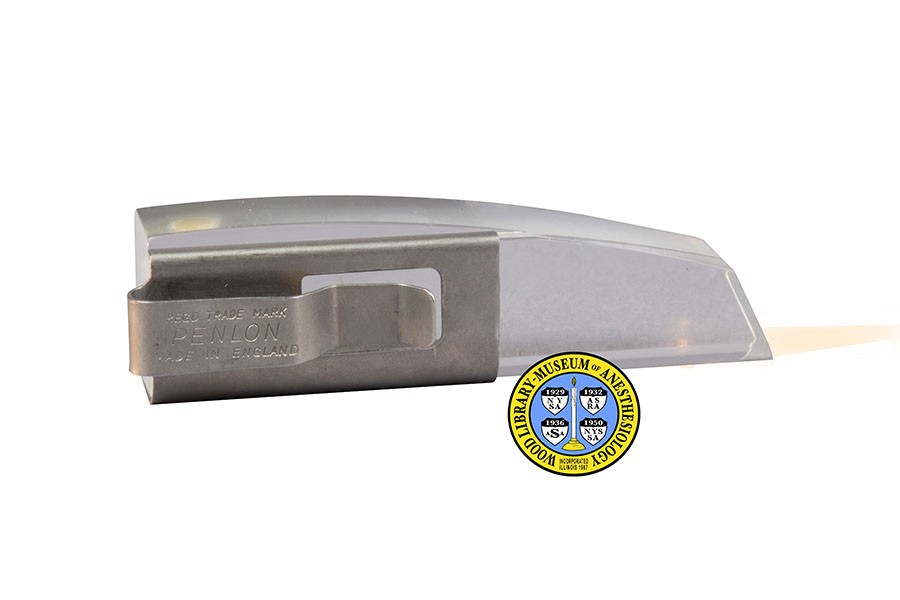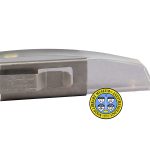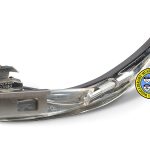Huffman Prism
John P. Huffman, C.R.N.A., designed this prism in 1958. It is a specially shaped piece of acrylic that clips onto the flange of a Macintosh Laryngoscope and was designed to allow an anesthesiologist to indirectly view a patient’s larynx (the opening to the lungs) in instances when a direct view was not possible.
Anesthesiologists need to see the larynx when they insert endotracheal (breathing) tubes for anesthesia and surgery. To do this, a tool called a laryngoscope, which is inserted through the mouth, is used to lift the tongue and tissue in the throat just enough to see the larynx. Some patients, such as those who have neck injuries or unusual anatomy, cannot be intubated by the usual method. The Huffman Prism was shaped so that it refracts light at a 30 degree angle to allow visualization of the larynx when it is not directly in the line of sight. This allowed anesthesiologists to safely insert an endotracheal tube via “indirect” visualization.
Mr. Huffman also designed a plastic laryngoscope with an integrated prism, and a two-prism laryngoscope. Prior to Mr. Huffman, other innovators had incorporated mirrors into laryngoscopy (such as the Siker Laryngoscope). However, the image reflected in mirrors was upside-down. Earlier prisms were made of glass and thus were heavier, not as easy to shape, and yielded images with a green tint. Prisms and prism laryngoscopes are still available but in the U.S. they have largely been replaced by flexible video endoscopy.
(NB: One view shows it attached to a Penlon Macintosh blade.)
Catalog Record: Huffman Prism
Access Key: amqs
Accession No.: 2003-11-07-1 J 8
Title: [Huffman prism] / [designed by John Huffman].
Author: Huffman, John P.
Title variation: Alt Title
Title: The Huffman clip-on prism for the Macintosh laryngoscope.
Publisher: England : Penlon, [between 1958 and 2003].
Physical Descript: 1 intubation aid : acrylic, metal (stainless steel?] ; 2 x 2 x 7 cm.
Subject: Intubation, Intratracheal – instrumentation.
Subject: Difficult Airway – management.
Subject: Airway Management – instrumentation.
Note Type: General
Notes: The early year in the date range for the possible year of manufacture is
based on the year of the first publication found to mention the device
(Huffman, 1958). However, because John Huffman lived in Chicago and this
particular prism was manufacture in England, it is likely that this prism was
manufacture sometime after 1958. The end year is based on the year that the
prism was donated to the WLM. The range of years in which Penlon manufactured
the Huffman Prism was not determined by this cataloger. The date range could
change if documentation or expert opinion indicate the range should be
corrected.
Note Type: General
Notes: The title is taken from the first publication by Mr. Huffman in which the
prism is referred to by a name (Huffman, 1970). In his 1968 publication he
only refers to ‘the prism’, ‘the plexiglass prism’ and the ‘prism method’.
Based on a search of Goggle Books (October 28, 2015) the device is commonly
referred to has the Huffman Prism, and sellers of the device also refer to it
as the Huffman Prism.
Note Type: Citation
Notes: Huffman J. The application of prisms to curved laryngoscopes: a preliminary
study. J Am Assoc Nurse Anesth. 1968;36(2):138-139.
Note Type: Citation
Notes: Huffman J. The development of optical prism instruments to view and study the
human larynx: a technique of indirect larynges-pharyngoscopy. J Am Assoc
Nurse Anesth. 1970;38(3):197-202.
Note Type: Citation
Notes: Huffman JP, Elam JO. Prisms and fiber optics for laryngoscopy. Anesth Analg.
1997; 50(1):64-67. https://journals.lww.
com/anesthesia-analgesia/Citation/1971/01000/Prisms_and_Fiber_Optics_for_Lary
goscopy_.12.aspx. Accessed October 29, 2015.
Note Type: Citation
Notes: Huffman JP, Foltz CL. Laryngoscope. U.S. patent 3,771,514. November 13, 1973.
https://patents.google.com/patent/US3771514A/en. Accessed October 29, 2015.
Note Type: Citation
Notes: Huffman JP. An indirect-direct laryngoscope. Anesth Analg. 1975;54(3):404-405
https://journals.lww.
com/anesthesia-analgesia/Citation/1975/05000/An_Indirect_Direct_Laryngoscope_
41.aspx. Accessed October 29, 2015.
Note Type: Citation
Notes: Janeway HH. Intra-tracheal anesthesia from the sandpoint of the noe, throat
and oral surgeon with a description of a new instrument for catheterizing the
trachea. Laryngoscope. 2013;23(11):1082-1090. https://ia700408.us.archive.
org/12/items/laryngoscope23ameruoft/laryngoscope23ameruoft_bw.pdf. Accessed
October 29, 2015.
Note Type: Citation
Notes: Mackenzie M. The Use of the Laryngoscope in Diseases of the Throat with an
Appendix on Rhinoscopy. London: Robert Hardwicke; 1865:19-37. https://books.
google.com/books?id=NRcDAAAAQAAJ&printsec=frontcover#v=onepage&q&f=false.
Accessed October 29, 2015.
Note Type: Physical Description
Notes: One clear oblong piece of acrylic (Plexiglass) with a metal (stainless
steel?) clip attached; The measurements and description are based on the
perspective of an anesthesiologist looking through the prism, as they would
when it is attached to a laryngoscope blade in use; It measures approximately
1.8 cm in height, 1.9 cm in width (including clip) and 6.8 cm in depth
(including clip); The ‘face’, or external end, of the prism is cut at a 90
degree angle to the straight superior surface of the prism; The inferior
surface is curved, and the interior end is cut at a 30 degree bevel; All
sides of the prism are polished so that the piece is clear; The clip is
located on the left side of the prism so that it may be attached to the
vertical flange of a laryngoscope blade; The following manufacture markings
have been engraved or stamped onto the clip, “REGD TRADE MARK [new line]
PENLON [new line] MADE IN ENGLAND”.
Note Type: Reproduction
Notes: Photographed for the WLM by Mr. Steve Donisch in June, 2015.
Note Type: Acquisition
Notes: Donated to the WLM by Jack Milowsky, MD.
Note Type: Exhibition
Notes: Selected for the WLM website (noted October 28, 2015).



